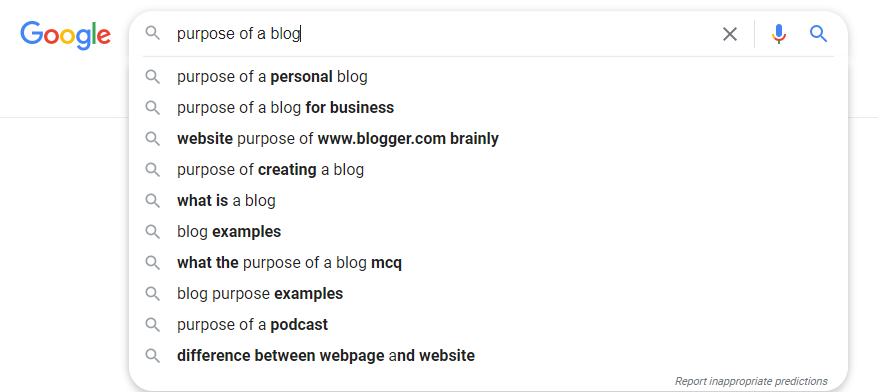
Google continues to focus on user search intent. If you want your content to be served up in search results, it needs to match the intent behind your customers’ search queries. Search intent is the “why” behind someone’s search for information and the “what” they are hoping to find. To that end, the search engine has become increasingly sophisticated in its ability to understand search queries semantically.
Long-tail search queries, often in the form of questions, help searchers find exactly the information they need. Your keyword strategy should match the search queries your customers are using. In this article, you’ll find three tools to help you determine the questions your customers are searching so you can use them in your content and SEO strategies.
How do you determine what questions your customers are searching? Keyword research is the best way to quickly uncover search queries your customers are using when searching for answers to their most pressing questions. When your website link appears on page one of search results for these queries and you’ll be one step ahead of your competition.
Keyword Research for Search Intent: What Questions Are Your Customers Asking?
These three free tools will help you uncover queries that match your customers’ search intent.
- Google Search Console
- People Also Ask
- SEMrush Keyword Magic – Questions
Google Search Console
Search Console’s Performance on Search Results report shows the top search queries that people used to find your site. Search Console doesn’t give you all of the search query data that lead to impressions in search results and clicks to your site. And, it shows the queries people currently use to find your site, not queries you could potentially leverage to help people find your site. However, it’s a good starting point for more extensive keyword research in other tools.
How to Use Search Console to Determine Top Queries for Your Website
Log in to Search Console and click Search Results. On the first page of the results, you’ll see the top 10 queries that resulted in clicks from the SERP to your website over the past three months. You can change the filter to view results over a different time period. You can also choose to include data on the click-through rate and position in search results. Export the data and then you’ll be able to use the list of keywords to do further research.
You may want to drill down into data on the pages that are getting clicks and impressions from those top terms. Click on the Pages tab and you’ll see which of your website pages are driving the most traffic to your website. From there you can click on the website link and it will give you the search queries that are being used to serve up your pages in search results.
After clicking on a website link, click Queries again to see the search queries for that webpage.
What to Do With the Data
Using Search Console to analyze your site’s performance in search enables you to see which terms you are ranking for and their position. Use this data to determine which pages to optimize around those keywords to improve their position in the SERPs (search engine results pages).
A tool like Frase.io will help you optimize those pages. Simply input the URL, the keyword you want to optimize for, and it will compare your page to the pages ranking on the first page of search results. It provides a list of topics (keywords) to include in your page and questions your competitors are answering in their content.
As previously mentioned, Search Console provides data on your site’s current performance in search. To improve your rankings for terms you’re not currently ranking for, you’ll want to do some keyword research on related terms. Google’s People Also Ask and SEMrush’s Keyword Magic Tool are great tools for further research.
People Also Search For and People Also Ask
Want to know what searchers are asking? It doesn’t get any easier than checking the “People also search for” and “People also ask” features located right on the SERP.
How to Use People Also Search For and People Also Ask
Take one of your queries from Search Console and enter it in Google Search and see what Google serves up as related searches.
While you’re searching, check out the “predictive search” terms.
Google is telling you exactly what people are searching for that is related to your search query. These are terms your potential customers are using to find businesses like yours. And, they are terms your competitors are using in their content.
What to Do With the Data
Clicking on a term in the “People also search for” box directs the user to another SERP. However, when they click on a “People also ask” term, it expands to reveal a link that answers that question. If Google links your page in People also ask, it indicates that Google thinks your content best answers the searchers’ question. Your goal should be to earn this spot on the SERP because they will drive traffic to your site when people click through to read your content.
Use the information from these features on the SERP to inform your content creation and optimization strategies. When your content answers your customers’ specific search queries (or what content marketers and SEOs call “user intent”), Google is more likely to serve your content in search results. It’s as simple as that.
SEMrush Keyword Magic Tool
SEMrush’s Keyword Magic Tool is a powerful keyword research tool that enables you to filter by Questions to uncover search queries related to your main keyword.
How to Use SEMrush Keyword Magic
You’ll need to register for SEMrush to use the Keyword Magic Tool. Free plans are available. Once you log in, select Keyword Magic Tool from the list of SEO tools.
Then enter your keyword and select the Questions tab.
What to Do With the Data
The Keyword Magic Tool will likely give you results similar to what you found in the People also ask and People also search for features. The benefit of using this tool is that it also gives you the search volume, trend, keyword difficulty, competition score, and the search features available for those terms. Use this data to determine any gaps in your content strategy. Are there questions your potential customers are asking that you are not currently answering in your content? If so, make a plan to publish content on your site that answers those questions. Focus on the questions with the highest search volume, that are trending upward and have lower keyword difficulty.
The Benefits of Publishing Content That Matches Search Queries
Google is increasingly focused on providing a user experience that enables searchers to find answers to their questions right on the SERP. To that end, they publish content on the SERP that best matches user intent. By publishing content on your website that answers your customers’ search queries, you inform Google that your content is authoritative on that topic.
Answering specific user questions enables your website to earn the featured snippet, as well as spots in the People also ask feature. If you organize your content in the form of frequently asked questions, you can add FAQ schema to your page and possibly earn the FAQ rich feature. All of these rich features occupy highly valuable real estate on the SERP.
Spend some time reviewing Search Console and then dive deeper into the search queries customers use to find businesses like yours. Use Google’s SERP features and SEMrush’s Keyword Magic Tool to develop a content strategy to write content to answer those questions.

